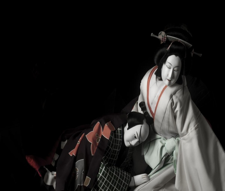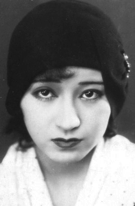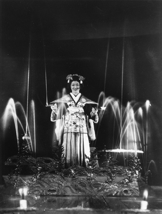The Silenced Voice of the Modern Girl in Mizoguchi Kenji’s The Water Magician: Examining the Role of Women in Early Japanese Cinema
By Wakako Suzuki
As part of my project, I examine a black and white silent movie titled The Water Magician, or “Taki no Shiraito,” directed by Mizoguchi Kenji in 1933. The film is based on Izumi Kyōka’s 1894 short story, titled Giketsu kyōketsu (Loyal Blood, Heroic Blood). Kyōka’s story employs the traditional cultural motif of double suicide between two lovers, known as sinjū-mono in Japanese. Dramatist Chikamatsu Monzaemon popularized the sinjū-mono theme in puppet plays during the late Edo period, and the theme of sinjū-mono continued to appear in various cultural contexts in modern Japan.
To some extent, Kyōka’s story also reflects this cultural motif of lovers’ suicide pacts. However, Mizuguchi’s film version moves beyond the traditional motif because it explores deep inner voices of the female character, Taki no Shiraito, who lives on the social periphery; the movie combines powerful acting, a dramatic storyline, and silent film production value to produce a melodramatic effect. In particular, Irie Takako, a prominent Japanese film actress, projects herself into Taki no Shiraito by synthesizing the image of the powerful modern girl which she embodied, with that of a sacrificial woman who acts with honor and benevolence. Irie also established the production company which produced The Water Magician. Around the same time, American actress Clara Bow became a cultural icon of the modern girl in Japan. Like Bow, Irie also represented a new type of woman; one emancipated from fixed social roles and norms.
The Water Magician, however, somewhat counters the discourse of the modern girl, as it confines women’s roles to those of sacrificial figures under the power of money and markets. The film illuminates the way that early melodrama’s commodification of sentimentalism both liberated and limited women’s roles.
The Content of the Film
In The Water Magician, Shiraito is an artist who specializes in water performances. While she is a very independent woman who makes a lot of money due to these amazing skills and her beauty, her social status is very low because she is a female entertainer with no spouse. Her traditional style of performance and appearance represents national nostalgia for a cultural past and tradition.
In the film, Shiraito encounters Murakoshi Kin’ya, a carriage driver. Kin’ya later loses his job because passengers, including Shiraito, urge him to hurry up to compete with the modern rickshaw; indeed, Kin’ya’s company gets complaints from the rickshaw company about the contests between horses and men. Without knowing that he’s been fired, Shiraito coincidentally meets Kin’ya again one summer evening on the Tenjin Bridge in Kanazawa. Shiraito encourages Kin’ya to talk about his life story, as she feels that he does not look like a mere carriage driver. Indeed, Kin’ya explains that he is descended from a former samurai family, but he’s been struggling to survive after his father passed away. Jobless, Kin’ya has been unable to continue his studies. Shiraito, who is already attracted to Kin’ya, offers to use her money to support his education. With Shiraito’s financial support, Kin’ya is able to continue his studies in Tokyo, and eventually becomes a judge. Meanwhile, Shiraito gradually loses her financial power due to the decline of her entertainment business and she eventually kills a rich man in order to keep supporting Kin’ya. Shiraito’s trial is held at the courthouse where Kin’ya has become a judge, and he must now sentence her to death. Shiraito understands his obligation, and she confesses her crime at court, in front of Kin’ya. She then commits suicide by biting off her tongue. After Kin’ya fulfills his duty, he then also commits suicide.
The movie’s ending gives the notion of the double suicide a unique twist. Shiraito is both a sacrificial figure, and also represents dokufu, or the figure of the poison woman. The poison woman was a powerful discourse about stigmatized women being dangerous in Japan during the 1870s. In Chikamatsu’s puppet play, the lovers chose death as a culmination of their love, torn between duty and humanity. In the Water Magician, however, there is no clear indication that both Shiraito and Kin’ya are in love.
Although the audiences might sense the characters’ mutual feelings and respect , the manifestation of their love is rather subtle and sensitive. It appears as though both characters actually value their duty more than their love, which deviates from the conventions of edoesque romances associated with erotic desire. Whereas Shiraito adheres to her duty to financially support Kin’ya’s success, Kin’ya adamantly sticks to his obligation to perform his job as a judge even when he has to charge Shiraito as a criminal for helping him. Indeed, fulfilling his duty as a judge is one way of returning his debt of gratitude to Shiraito for her laborious support. The Water Magician thus offers an ironic view of what it meant by success and duty in the context of Japan’s modernization. The audience can sense the misery of the lovers, who can no longer die together as the culmination of their love. Shiraito’s role as a sacrificial figure is also overshadowed by her role as dokufu—that is to say, a murderous woman with seductive sexuality.
Topography of the Film
The film employs topographical perspectives to express the power dynamics between the city (Tokyo) and the country (Kanazawa) which spatially separate Shiraito from Kin’ya, as well as the complex relationship between the center and the periphery that creates a new social hierarchy. Kin’ya and Shiraito are able to meet on the riverbed in Kanazawa, where a variety of playhouses and cabins for street performances exist. In this established public space for traditional performances they are able to understand each other and bridge the gap caused by the difference in their backgrounds.
However, once Kin’ya leaves for Tokyo to pursue his education, the gap is made wider. Kin’ya’s success as a student distances him from the world of artists to which Shiraito belongs. Inoue notes, “In this modern world of promotion and success, a vast gulf comes to separate the public space of the riverbed from the public space of the courthouse”.[1] In this modern world, Kin’ya and Shiraito cannot be united because Kin’ya has been embedded in the modern system as a respectable public figure, while Shiraito still remains in the world of artists.
Indeed, examinations of The Water Magician reveal how the theme of double suicide, can be seen as an allegory for the residue of Japan’s feudal past. Similar to Chikamatsu’s shinjû-mono, we see the struggle of main characters who are torn between their senses of duty and humanity. But the modern concept of success and the discourse of a murderous woman ironically distort the narrative of double suicide. Shiraito, who represents the beauty of the artistic world, or the embodiment of new modern women, is now reduced to the mere poison woman of the Meiji discourse. Kin’ya, who achieved his success, cannot embrace romantic love anymore. Here we can see the residue of feudal culture and modernization in this story being expressed as complex irony.
The Rise of Irie Takako
Now, let me explain how this shift of cultural motif could connect to a rise of Irie as a movie star in relation to the development of consumer culture and modern girls in Japan during the latter half of the 1920s. While Irie Takako is well-known for appearing in a series of ghost movies in the postwar period, she was originally identified as a representative of modern girls and associated with new audiences who were themselves recognized as modern girls beyond social hierarchy. Irie was born in Tokyo into an aristocratic family (called the Higashibōjō family), and she debuted as an actress at Nikkatsu in 1927. She then became a popular star by performing a role in Mizoguchi Kenji’s Tokyo March in 1929 and starting the Irie Production, in 1932.
During that time, Clara Bow was also a cultural icon of modern girls in Japan. Although her original images were produced in the US, (not initially targeting the Japanese audience), she was also associated with the representation of modern girls in Japan. Clara Bow’s sensual appearance stimulated the formation of the modern girl persona in Japan even while it conflicted with cultural and even economic views among Japanese people. American stars like Bow enhanced the reactionary trend through which Japanese actresses became seen as modern girls.[2]
Similar to Bow, Irie was an influential actress popular with female audiences in the interwar period. She appeared in many advertisements, as well as on fans and other commercial goods, and was linked to consumer activities and national identity as well as to reactionary discourses. The modernity of her screen persona was juxtaposed with other images, such as aristocracy, sophistication, and decency. Yet, her off-screen image was that of a caring, submissive, beautiful, well dressed woman. Her autobiography suggests that she was a victim of other people’s ambitions, as though she were a living doll. Interestingly, the sense of victimhood as well as the feelings of submission described here resembles the image of Taki no Shiraito, the character Irie played in The Water Magician. Even though her own production company created the film The Water Magician, it has been said that the company was controlled by other people, not her, and that Mizoguchi Kenji’s name needed to be used for the creation of The Water Magician, since Irie wanted to conceal her sense of shame and inferiority about her own company.
Ironically, in this film, Irie also plays the role of an economically independent, beautiful performer who ends up sacrificing herself for her lover, for the sake of his success and ambition. Indeed, Shiraito represents a modern woman as both nostalgia for a cultural past and a yearning for modern melodrama in a capitalist society. Likewise, Irie Takako, as an actress best associated with the image of modern girls, really represents an ironic figure, such as a woman in Western clothes as well as in a kimono. Irie and her acting roles reveal her complex star persona. Both Irie and Shiraito are beautiful performers who have excellent skills and make a lot of money. At the same time, however, their roles are also sacrificial and submissive, their power and independence confined within a star system.
The Role of Benshi
Finally, it is essential for us to consider that the Water Magician was produced when the talkie came to replace the silent film in modern Japan. In Japan, a benshi, or “a silent film speaker,” a performer typically clad in a flock coat or a formal- crested kimono, would narrate motion pictures. Benshi would have had a powerful impact on the narrative structure of The Water Magician. For example, even though Taki no Shiraito does not utter a word, the audience feels her inner voice, which was conveyed by the benshi’s powerful narrative skills. Although film commentators in Western countries gradually disappeared during the early days of Western film, in Japan, as vital elements of cinematic spaces, the benshi continued to develop until talkies overwhelmingly superseded silent films in the mid-1930s.
In this context, it is interesting to see how the benshi express Shiraito’s deep inner voices. In silent films, the audience cannot hear an actress’s voice. But the benshi vicariously depicts the voice of the female character, whose real voice is silenced. At the same time, audiences also understand the materiality of silent films, including the fact that the benshi will never replace the character’s authentic voices. So they will never understand the true voice of both Taki no Shiraito nor Irie Takako.
Conclusion
To sum up, The Water Magician reflects the nostalgia for feudal Japanese culture and aesthetics which emerged as a form of resistance to the centralization of economic and cultural capital in the modern period. However, The Water Magician is ambivalent and tinged with melancholy. Both the main character and the actress who played her are like a mirror reflecting modernity. They represent the modern girl who is sexually powerful and independent. But they also reflect traditional values by representing a sacrificial figure and compassionate lover. If cinematic modernity emerges from the relationship between the past and the present reality, The Water Magician extends this logic by depicting the fusion between real and non-real as well as what is both rejected by, and retained in, the cultural imagination in the interwar period.
Wakako Suzuki is a graduate student in Asian Languages & Cultures. She received her Bachelor of Arts in German Literature from Rikkyo University and her Master of Arts in Japanese Literature from Stanford University. She is interested in the role of translation and adaptation in Japanese literature, with a particular focus on gendered language and women’s literary production in the late 19th and early 20th centuries. Among her interests is the adaptation of Izumi Kyōka’s literature. She was the recipient of a Travel Grant from the UCLA Center for the Study of Women. Learn more about how to apply for a CSW Travel Grant!
[1] Public Space and the Nature of Modern Fiction: Izumi Kyōka’s Noble Blood, Heroic Blood,” in Nara Hiroshi, ed., Inexorable Modernity: Japan’s Grappling with Modernity In the Arts (Lanham, Md.: Lexington Books, 2007), 219.
[2] Hideaki Fujiki, “Modern Girls and Clara Bow,” Making Personas: Transnational Film Stardom in Modern Japan (Cambridge: Harvard UP, 2013): 249-278.







Comments are closed.